airbag Acura RDX 2013 Owner's Manual
[x] Cancel search | Manufacturer: ACURA, Model Year: 2013, Model line: RDX, Model: Acura RDX 2013Pages: 364, PDF Size: 12.54 MB
Page 1 of 364
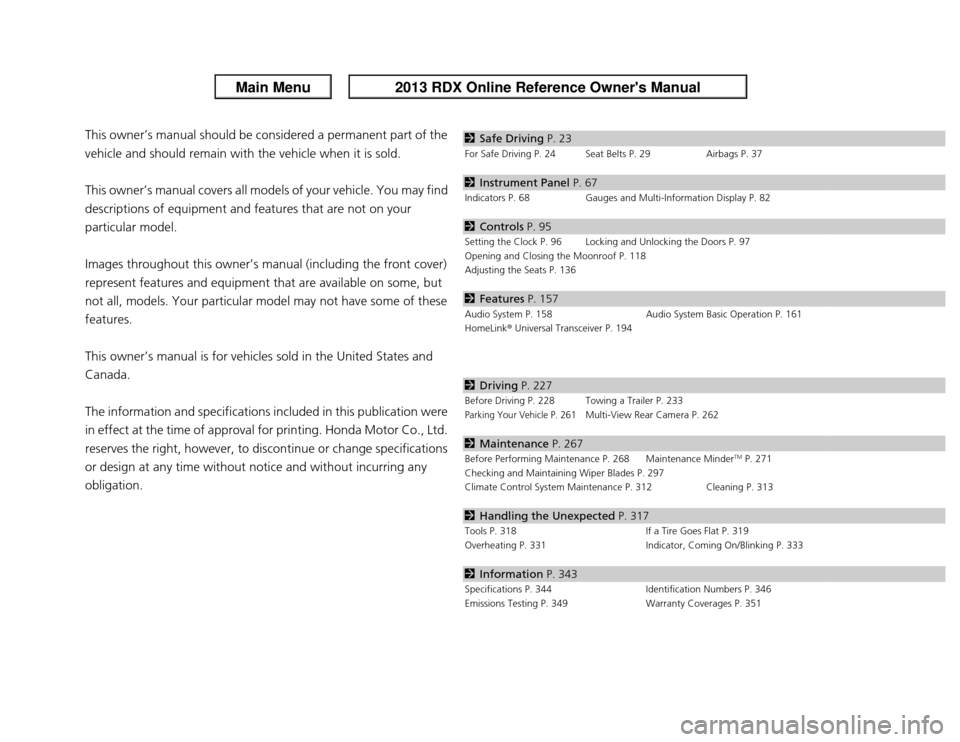
ContentsThis owner’s manual should be considered a permanent part of the
vehicle and should remain with the vehicle when it is sold.
This owner’s manual covers all models of your vehicle. You may find
descriptions of equipment and features that are not on your
particular model.
Images throughout this owner’s manual (including the front cover)
represent features and equipment that are available on some, but
not all, models. Your particular model may not have some of these
features.
This owner’s manual is for vehicles sold in the United States and
Canada.
The information and specifications included in this publication were
in effect at the time of approval for printing. Honda Motor Co., Ltd.
reserves the right, however, to discontinue or change specifications
or design at any time without notice and without incurring any
obligation.
2Safe Driving P. 23For Safe Driving P. 24 Seat Belts P. 29 Airbags P. 372Instrument Panel P. 67Indicators P. 68 Gauges and Multi-Information Display P. 822Controls P. 95Setting the Clock P. 96 Locking and Unlocking the Doors P. 97
Opening and Closing the Moonroof P. 118
Adjusting the Seats P. 1362Features P. 157Audio System P. 158 Audio System Basic Operation P. 161
HomeLink ® Universal Transceiver P. 1942 Driving P. 227Before Driving P. 228 Towing a Trailer P. 233Parking Your Vehicle P. 261
Multi-View Rear Camera P. 262
2Maintenance P. 267Before Performing Maintenance P. 268 Maintenance Minder
TM P. 271
Checking and Maintaining Wiper Blades P. 297
Climate Control System Maintenance P. 312 Cleaning P. 313
2 Handling the Unexpected P. 317Tools P. 318 If a Tire Goes Flat P. 319
Overheating P. 331 Indicator, Coming On/Blinking P. 3332Information P. 343Specifications P. 344 Identification Numbers P. 346
Emissions Testing P. 349 Warranty Coverages P. 351
Page 5 of 364
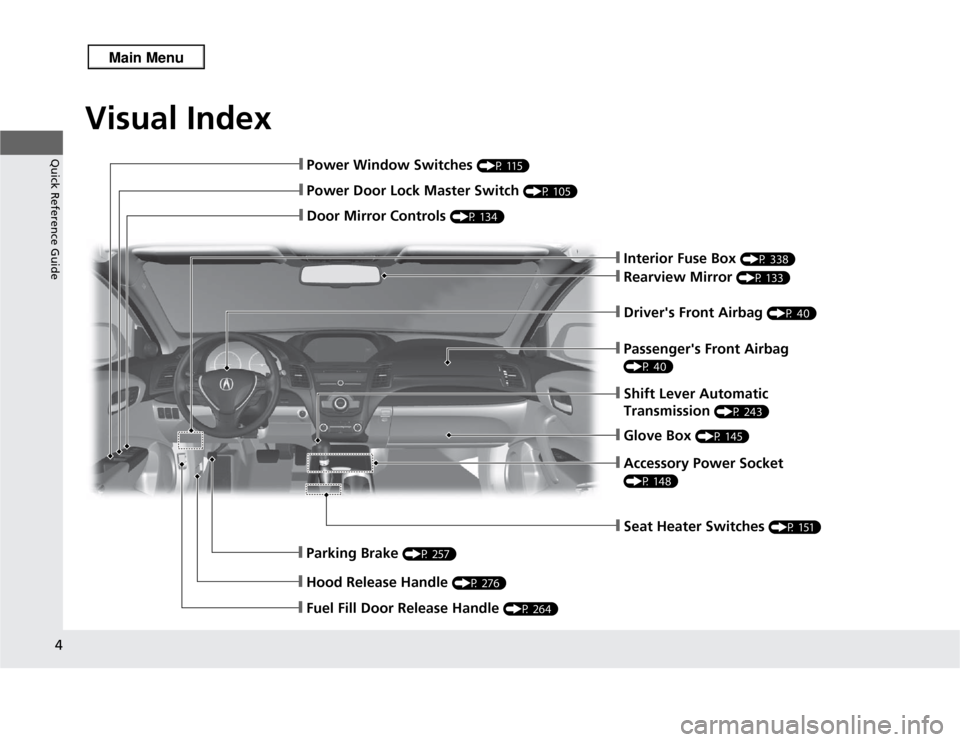
Visual Index
4Quick Reference Guide
❙Power Door Lock Master Switch
(P 105)
❙Power Window Switches
(P 115)
❙Rearview Mirror
(P 133)
❙Parking Brake
(P 257)
❙Hood Release Handle
(P 276)
❙Shift Lever Automatic
Transmission
(P 243)
❙Driver's Front Airbag
(P 40)
❙Door Mirror Controls
(P 134)
❙Passenger's Front Airbag (P 40)
❙Fuel Fill Door Release Handle
(P 264)
❙Glove Box
(P 145)
❙Accessory Power Socket (P 148)❙Seat Heater Switches
(P 151)
❙Interior Fuse Box
(P 338)
Page 6 of 364
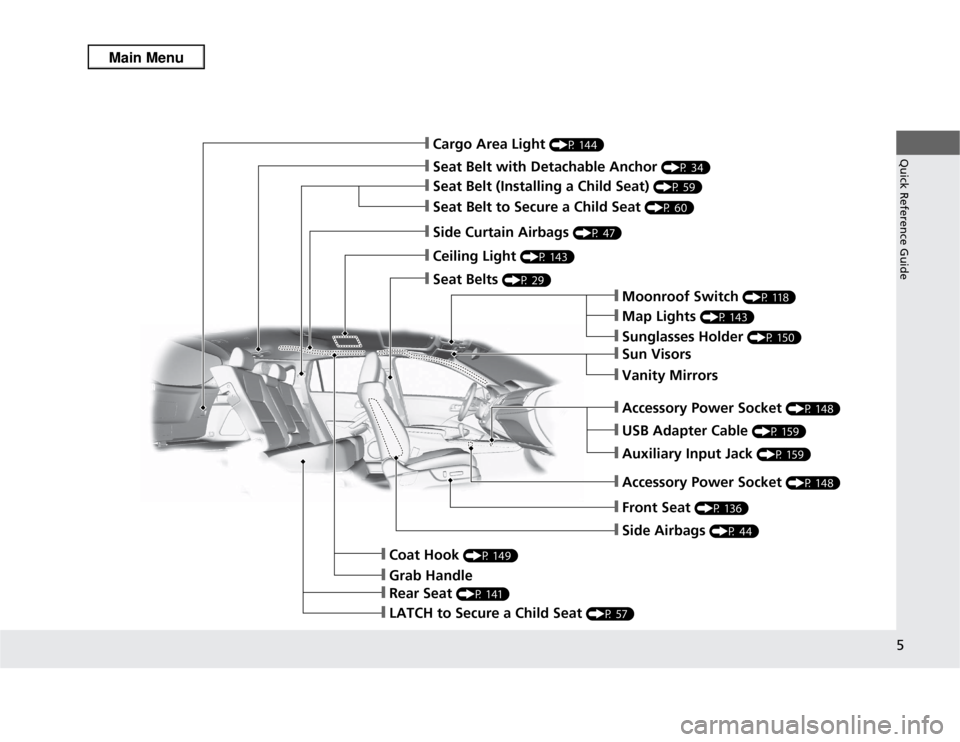
5Quick Reference Guide
❙Cargo Area Light
(P 144)
❙Seat Belt with Detachable Anchor
(P 34)
❙Seat Belt (Installing a Child Seat)
(P 59)
❙Seat Belt to Secure a Child Seat
(P 60)
❙Side Curtain Airbags
(P 47)
❙Ceiling Light
(P 143)
❙Seat Belts
(P 29)
❙Moonroof Switch
(P 118)
❙Map Lights
(P 143)
❙Sunglasses Holder
(P 150)
❙Sun Visors❙Vanity Mirrors❙USB Adapter Cable
(P 159)
❙Auxiliary Input Jack
(P 159)
❙Front Seat
(P 136)
❙Side Airbags
(P 44)
❙Coat Hook
(P 149)
❙Grab Handle❙Rear Seat
(P 141)
❙LATCH to Secure a Child Seat
(P 57)
❙Accessory Power Socket
(P 148)
❙Accessory Power Socket
(P 148)
Page 8 of 364
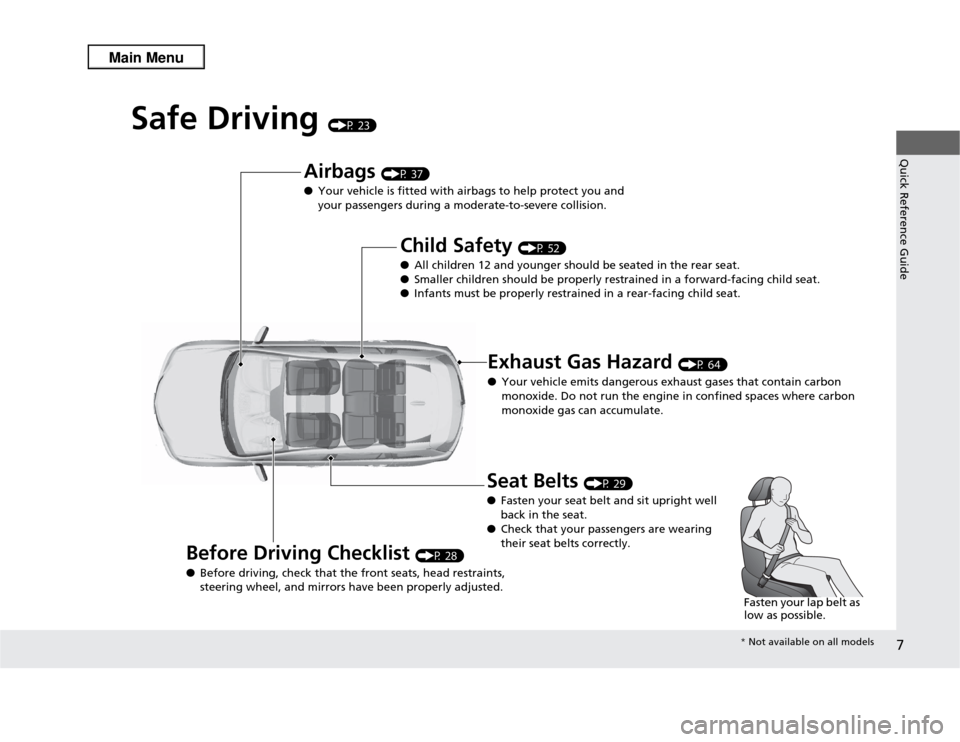
7Quick Reference Guide
Safe Driving
(P 23)
Airbags
(P 37)
● Your vehicle is fitted with airbags to help protect you and
your passengers during a moderate-to-severe collision.
Child Safety
(P 52)
● All children 12 and younger should be seated in the rear seat.
● Smaller children should be properly restrained in a forward-facing child seat.
● Infants must be proper ly restrained in a rear-facing child seat.
Exhaust Gas Hazard
(P 64)
● Your vehicle emits dangerous exhaust gases that contain carbon
monoxide. Do not run the engine in confined spaces where carbon
monoxide gas can accumulate.
Before Driving Checklist
(P 28)
● Before driving, check that the front seats, head restraints,
steering wheel, and mirrors have been properly adjusted.
Seat Belts
(P 29)
● Fasten your seat belt and sit upright well
back in the seat.
● Check that your passengers are wearing
their seat belts correctly.
Fasten your lap belt as
low as possible.* Not available on all models
Page 9 of 364

8Quick Reference Guide
Instrument Panel
(P 67)
System Indicators
Malfunction
Indicator Lamp
Low Oil Pressure
Indicator
Charging System
Indicator
Anti-lock Brake
System (ABS)
Indicator
Vehicle Stability
Assist (VSA ®) System
Indicator
VSA ® OFF Indicator
Low Tire Pressure/
TPMS Indicator
Lights Reminders
Lights On Indicator
High Beam Indicator
Fog Light Indicator
*
Immobilizer System
Indicator Seat Belt Reminder
Indicator
System Indicators
CRUISE CONTROL
Indicator
Parking Brake and
Brake System
Indicator (Red) Supplemental
Restraint System
Indicator
Side Airbag Off
Indicator
Door and Tailgate
Open Indicator
CRUISE MAIN
Indicator
Tachometer Speedometer
Fuel Gauge
Security System Alarm
Indicator
Shift Lever Position Indicator
Low Fuel Indicator
Gauges
(P 82)
/Multi-Information Display
(P 83)
/
System Indicators
(P 68)
System Message
Indicator
Brake System
Indicator (Amber)
Temperature Gauge
Electric Power
Steering (EPS) System
Indicator Turn Signal and
Hazard Warning
IndicatorsAWD
(All-Wheel
Drive) with
Intelligent Control
System Indicator
*
Canada U.S.
Canada
U.S.Canada
U.S.
Keyless Access System
Indicator
Page 22 of 364
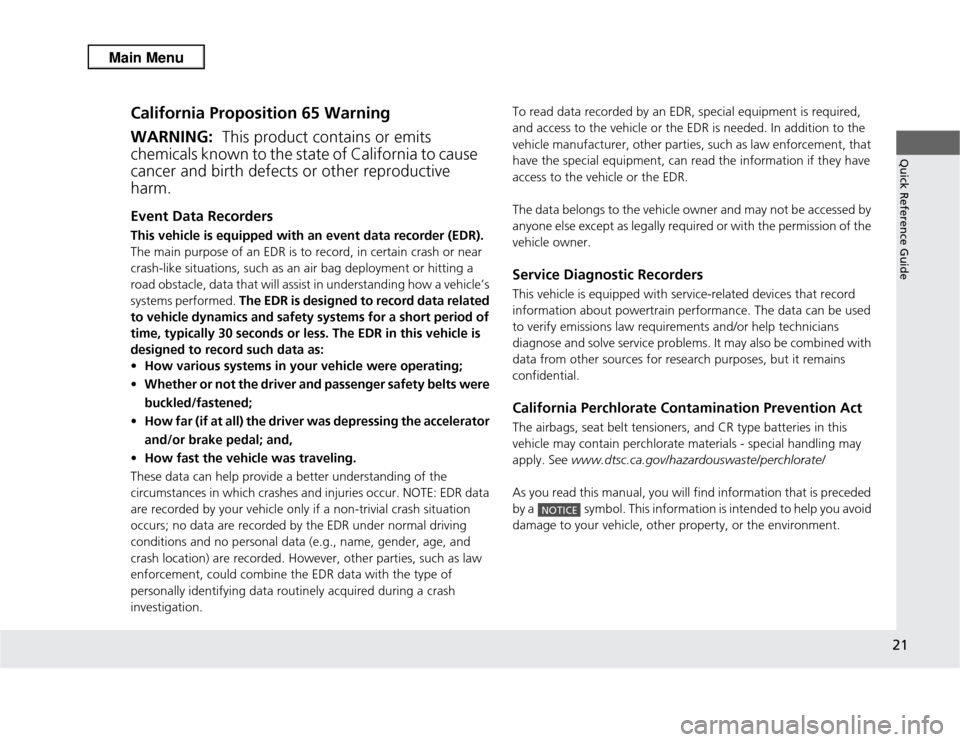
21Quick Reference Guide
California Proposition 65 WarningEvent Data RecordersThis vehicle is equipped with an event data recorder (EDR).
The main purpose of an EDR is to record, in certain crash or near
crash-like situations, such as an air bag deployment or hitting a
road obstacle, data that will assist in understanding how a vehicle’s
systems performed. The EDR is designed to record data related
to vehicle dynamics and safety systems for a short period of
time, typically 30 seconds or less. The EDR in this vehicle is
designed to record such data as:
• How various systems in your vehicle were operating;
• Whether or not the driver and passenger safety belts were
buckled/fastened;
• How far (if at all) the driver was depressing the accelerator
and/or brake pedal; and,
• How fast the vehicle was traveling.
These data can help provide a better understanding of the
circumstances in which crashes and injuries occur. NOTE: EDR data
are recorded by your vehicle only if a non-trivial crash situation
occurs; no data are recorded by the EDR under normal driving
conditions and no personal data (e.g., name, gender, age, and
crash location) are recorded. However, other parties, such as law
enforcement, could combine the EDR data with the type of
personally identifying data routinely acquired during a crash
investigation.WARNING: This product contains or emits
chemicals known to the state of California to cause
cancer and birth defects or other reproductive
harm.
To read data recorded by an EDR, special equipment is required,
and access to the vehicle or the EDR is needed. In addition to the
vehicle manufacturer, other parties, such as law enforcement, that
have the special equipment, can read the information if they have
access to the vehicle or the EDR.
The data belongs to the vehicle owner and may not be accessed by
anyone else except as legally required or with the permission of the
vehicle owner.Service Diagnostic RecordersThis vehicle is equipped with service-related devices that record
information about powertrain performance. The data can be used
to verify emissions law requirements and/or help technicians
diagnose and solve service problems. It may also be combined with
data from other sources for research purposes, but it remains
confidential.California Perchlorate Contamination Prevention ActThe airbags, seat belt tensioners, and CR type batteries in this
vehicle may contain perchlorate materials - special handling may
apply. See www.dtsc.ca.gov/hazardouswaste/perchlorate/
As you read this manual, you will find information that is preceded
by a symbol. This information is intended to help you avoid
damage to your vehicle, other property, or the environment.
NOTICE
Page 24 of 364
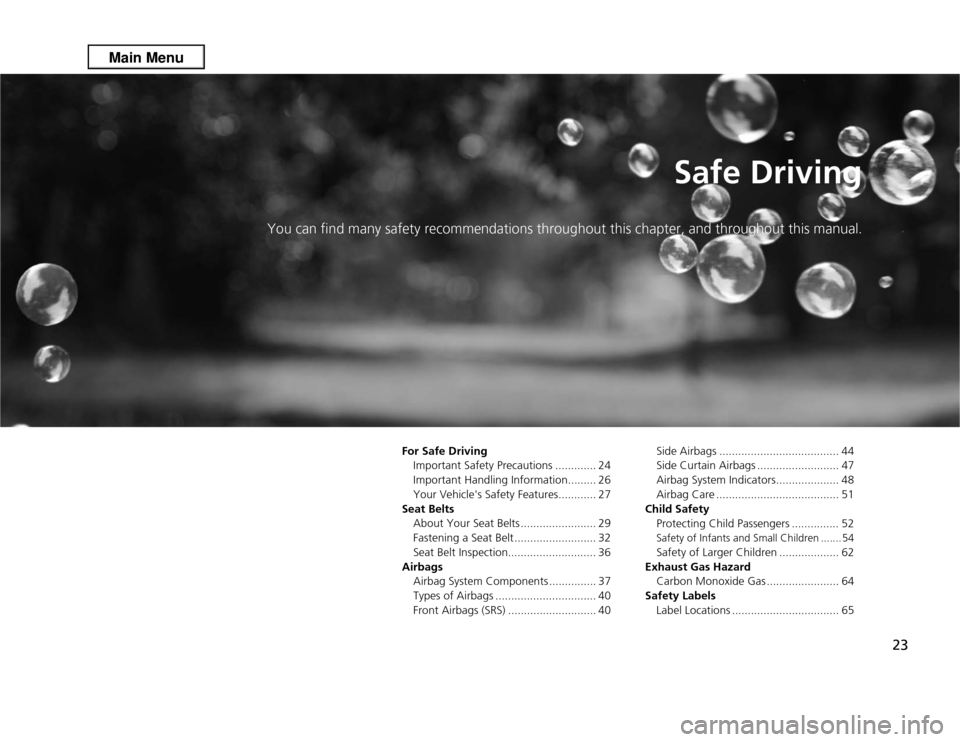
23
Safe Driving
You can find many safety recommendations throughout this chapter, and throughout this manual.
For Safe Driving
Important Safety Precautions ............. 24
Important Handling Information......... 26
Your Vehicle's Safety Features............ 27
Seat Belts About Your Seat Belts ........................ 29
Fastening a Seat Belt .......................... 32
Seat Belt Inspection............................ 36
Airbags Airbag System Components ............... 37
Types of Airbags ................................ 40
Front Airbags (SRS) ............................ 40 Side Airbags ...................................... 44
Side Curtain Airbags .......................... 47
Airbag System Indicators.................... 48
Airbag Care ....................................... 51
Child Safety Protecting Child Passengers ............... 52
Safety of Infants and Small Children ....... 54Safety of Larger Children ................... 62
Exhaust Gas Hazard Carbon Monoxide Gas ....................... 64
Safety Labels Label Locations .................................. 65
Page 25 of 364
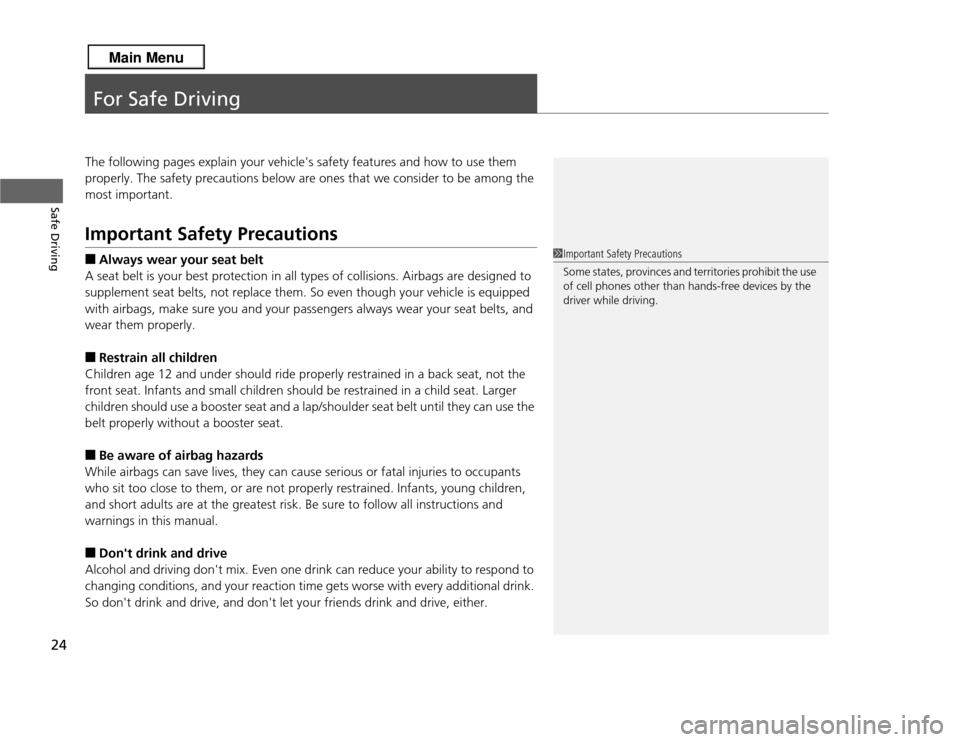
24Safe Driving
For Safe DrivingThe following pages explain your vehicle's safety features and how to use them
properly. The safety precautions below are ones that we consider to be among the
most important.Important Safety Precautions■
Always wear your seat belt
A seat belt is your best protection in all types of collisions. Airbags are designed to
supplement seat belts, not replace them. So even though your vehicle is equipped
with airbags, make sure you and your passengers always wear your seat belts, and
wear them properly.
■
Restrain all children
Children age 12 and under should ride properly restrained in a back seat, not the
front seat. Infants and small children should be restrained in a child seat. Larger
children should use a booster seat and a lap/shoulder seat belt until they can use the
belt properly with out a booster seat.
■
Be aware of airbag hazards
While airbags can save lives, they can cause serious or fatal injuries to occupants
who sit too close to them, or are no t properly restrained. Infants, young children,
and short adults are at the greatest risk. Be sure to follow all instructions and
warnings in this manual.
■
Don't drink and drive
Alcohol and driving don't mix. Even one drink can reduce your ability to respond to
changing conditions, and your reaction time gets worse with every additional drink.
So don't drink and drive, and don't let your friends drink and drive, either.
1 Important Safety Precautions
Some states, provinces and territories prohibit the use
of cell phones other than hands-free devices by the
driver while driving.
Page 28 of 364
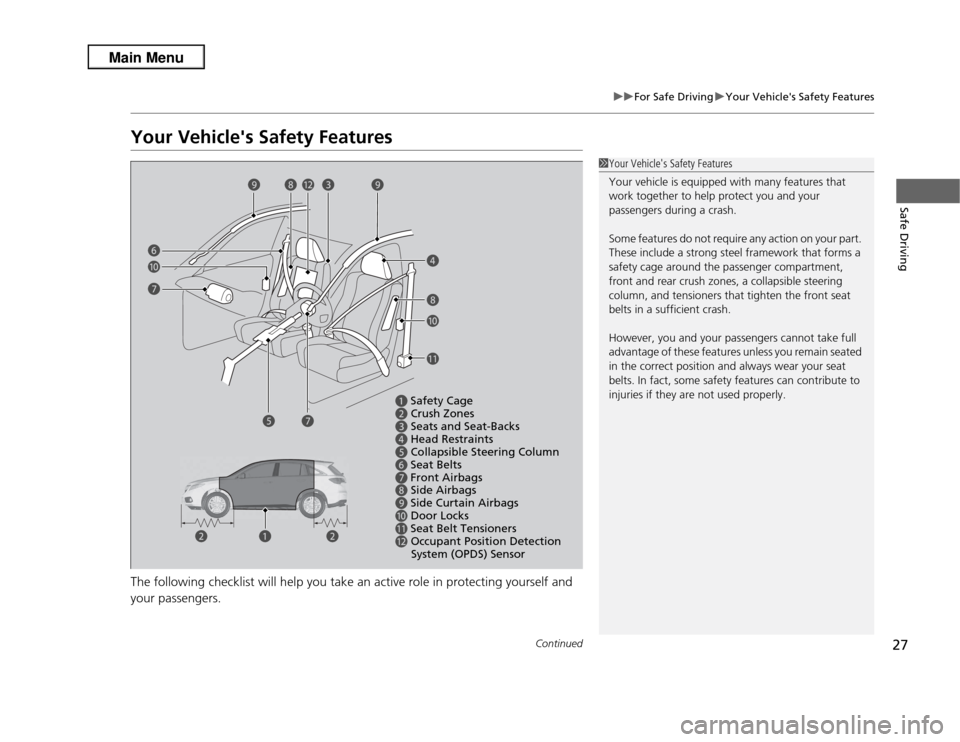
27
uuFor Safe Driving uYour Vehicle's Safety Features
Continued
Safe Driving
Your Vehicle's Safety FeaturesThe following checklist will help you take an active role in protecting yourself and
your passengers.
1Your Vehicle's Safety Features
Your vehicle is equipped with many features that
work together to help protect you and your
passengers during a crash.
Some features do not require any action on your part.
These include a strong steel framework that forms a
safety cage around the passenger compartment,
front and rear crush zones, a collapsible steering
column, and tensioners that tighten the front seat
belts in a sufficient crash.
However, you and your passengers cannot take full
advantage of these features unless you remain seated
in the correct position and always wear your seat
belts. In fact, some safety features can contribute to
injuries if they are not used properly.
a
Safety Cage
b
Crush Zones
c
Seats and Seat-Backs
d
Head Restraints
e
Collapsible Steering Column
f
Seat Belts
g
Front Airbags
h
Side Airbags
i
Side Curtain Airbags
j
Door Locks
k
Seat Belt Tensioners
l
Occupant Position Detection
System (OPDS) Sensor
a
bb e
f
il
j
k
g h
d
c
g j h
i
Page 29 of 364
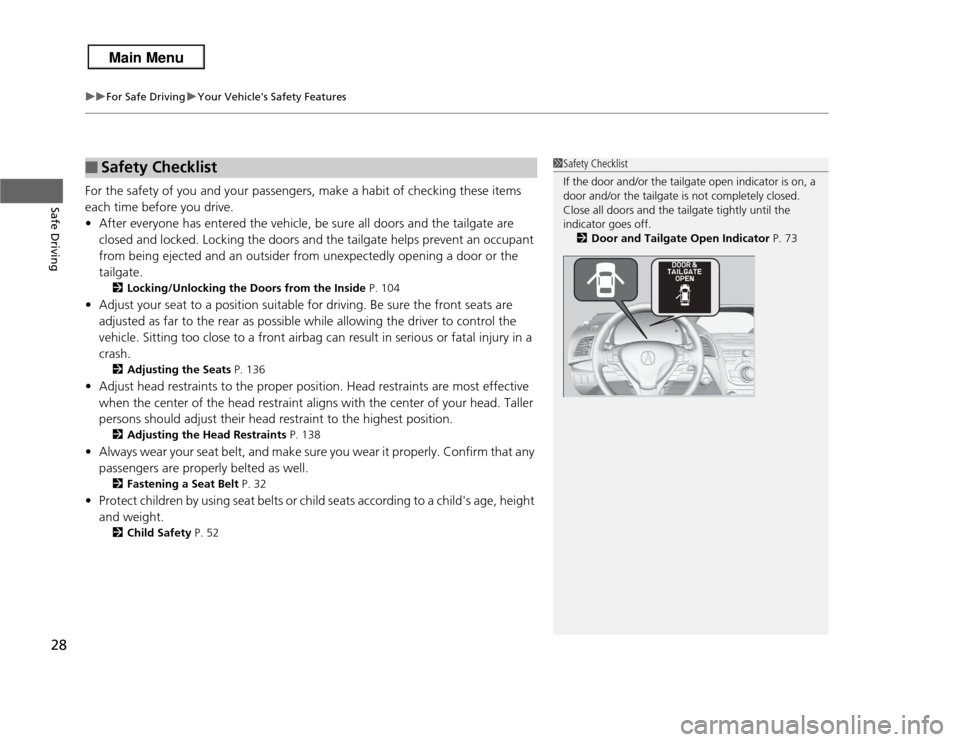
uuFor Safe Driving uYour Vehicle's Safety Features
28Safe Driving
For the safety of you and your passengers, make a habit of checking these items
each time before you drive.
• After everyone has entered the vehicle, be sure all doors and the tailgate are
closed and locked. Locking the doors and the tailgate helps prevent an occupant
from being ejected and an outsider from unexpectedly opening a door or the
tailgate.
2 Locking/Unlocking the Doors from the Inside P. 104
•Adjust your seat to a position suitable for driving. Be sure the front seats are
adjusted as far to the rear as possible while allowing the driver to control the
vehicle. Sitting too close to a front airbag can result in serious or fatal injury in a
crash.
2 Adjusting the Seats P. 136
•Adjust head restraints to the proper position. Head restraints are most effective
when the center of the head restraint aligns with the center of your head. Taller
persons should adjust their head restraint to the highest position.
2 Adjusting the Head Restraints P. 138
•Always wear your seat belt, and make sure you wear it properly. Confirm that any
passengers are properly belted as well.
2 Fastening a Seat Belt P. 32
•Protect children by using seat belts or child seats according to a child's age, height
and weight.
2 Child Safety P. 52
■
Safety Checklist
1Safety Checklist
If the door and/or the tailgate open indicator is on, a
door and/or the tailgate is not completely closed.
Close all doors and the tailgate tightly until the
indicator goes off.
2 Door and Tailgate Open Indicator P. 73